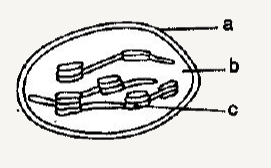Name the part of a cell in which many chemical reactions occur with the help of enzymes.
Step-by-Step Solution:
1. Understanding the Question: The question asks for the specific part of a cell where many chemical reactions occur, facilitated by enzymes.
2. Identifying Cell Components: In a typical cell, there are various components such as the nucleus, mitochondria, ribosomes, and cytoplasm. Each part has specific functions.
3. Focusing on Chemical Reactions: Chemical reactions in a cell are crucial for metabolism and energy production. These reactions often require enzymes, which are biological catalysts.
4. Recognizing the Role of Cytoplasm: The cytoplasm is the gel-like substance within the cell membrane that surrounds the organelles. It is known to be the site where many biochemical reactions occur.
5. Enzymatic Activity in Cytoplasm: Enzymes present in the cytoplasm help in breaking down larger molecules into smaller ones, which can then be utilized by other organelles for various functions.
6. Examples of Reactions: Some specific reactions that occur in the cytoplasm include glycolysis, which is a process of breaking down glucose for energy, and other metabolic pathways.
7. Conclusion: Based on the above points, the part of the cell where many chemical reactions occur with the help of enzymes is the cytoplasm.
Final Answer: Cytoplasm
---
Topper's Solved these Questions
- CELL: THE UNIT OF LIFEBOOK - ICSECHAPTER - CELL: THE UNIT OF LIFEEXERCISE - REVIEW QUESTIONS ( A. MULTIPLE CHOICE TYPE)
6 Videos
- CELL: THE UNIT OF LIFEBOOK - ICSECHAPTER - CELL: THE UNIT OF LIFEEXERCISE - REVIEW QUESTIONS (B. VERY SHORT ANSWER TYPE )
22 Videos
- BASIC BIOLOGYBOOK - ICSECHAPTER - BASIC BIOLOGYEXERCISE - TOPIC 3 (5 MARKS QUESTIONS )
1 Videos
- CELL:THE UNIT OF LIFE BOOK - ICSECHAPTER - CELL:THE UNIT OF LIFE EXERCISE - TOPIC 3(5 Mark Questions )
14 Videos
Similar Questions
Knowledge Check
An enzyme promotes a chemical reaction by
Aincreasing molecular motionBlowering the energy of activationCcausing the release of heat, which acts as a primerDchanging the free energy difference between substrate and productAn enzyme promotes a chemical reaction by
Aa) lowering the energy of activationBb) changing the free energy difference between substrate and productCc) increasing molecular motionDd) All of these
State three characteristics that show a chemical reaction has occurred.
View SolutionName two elements which show chemical reactions similar to magnesium.
View SolutionSubstances that take part in a chemical reaction
View SolutionIn the diagram drawn alongside
(i) Label the parts a, b and c.
(ii) In which part does the light reaction occur?
(iii) Name the part which the dark phase of photosynthesis occur in.
View SolutionName a cell that has many nuclei
View SolutionEnzymes increase rate of chemical reaction by
View Solution
